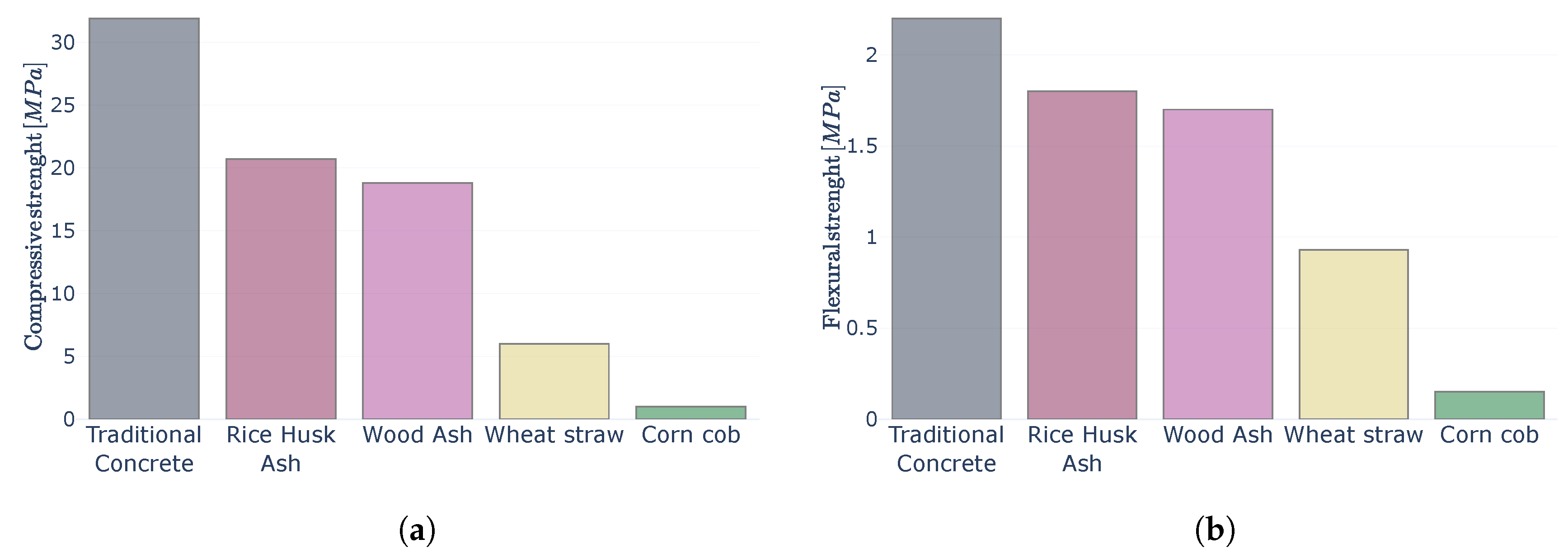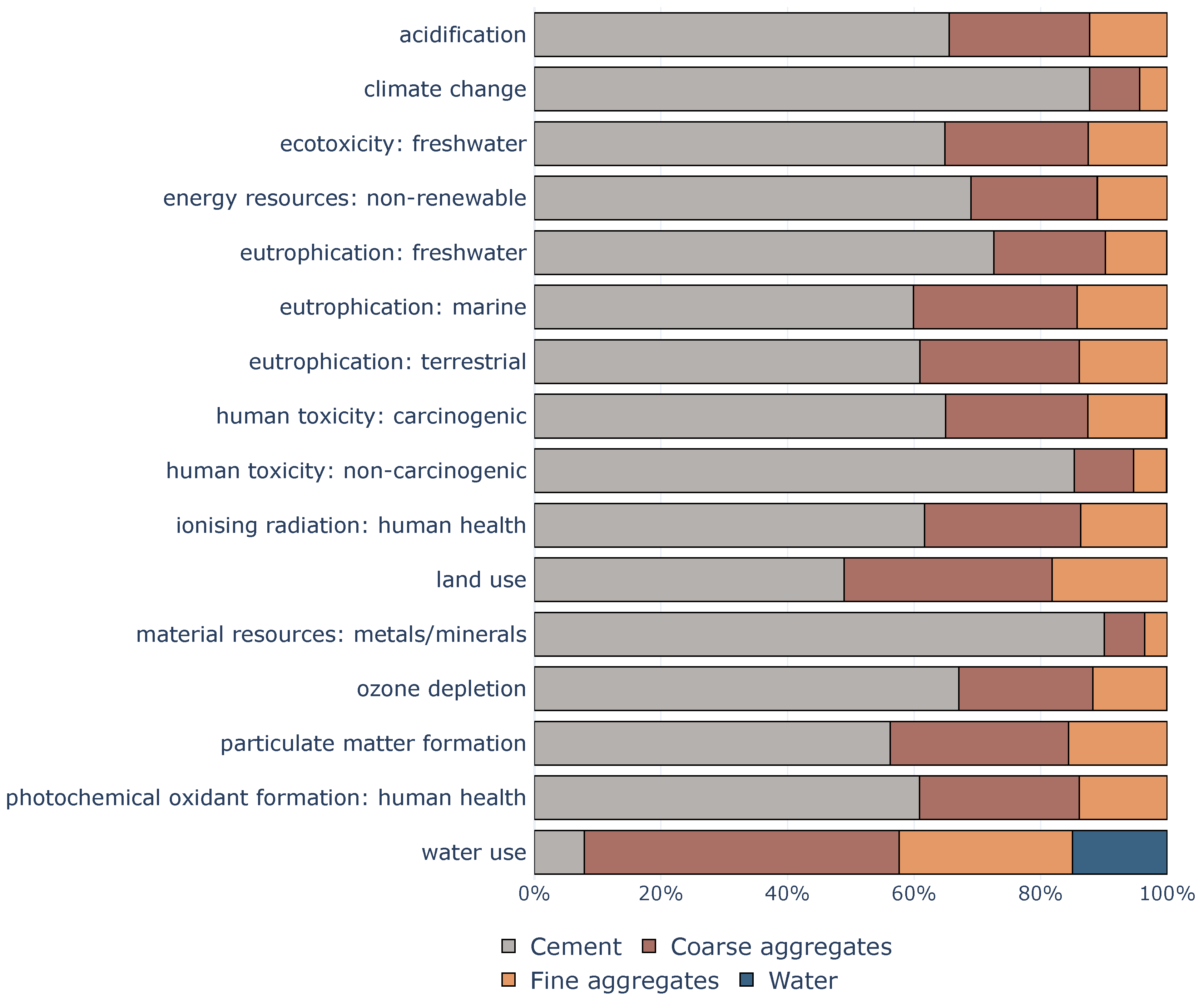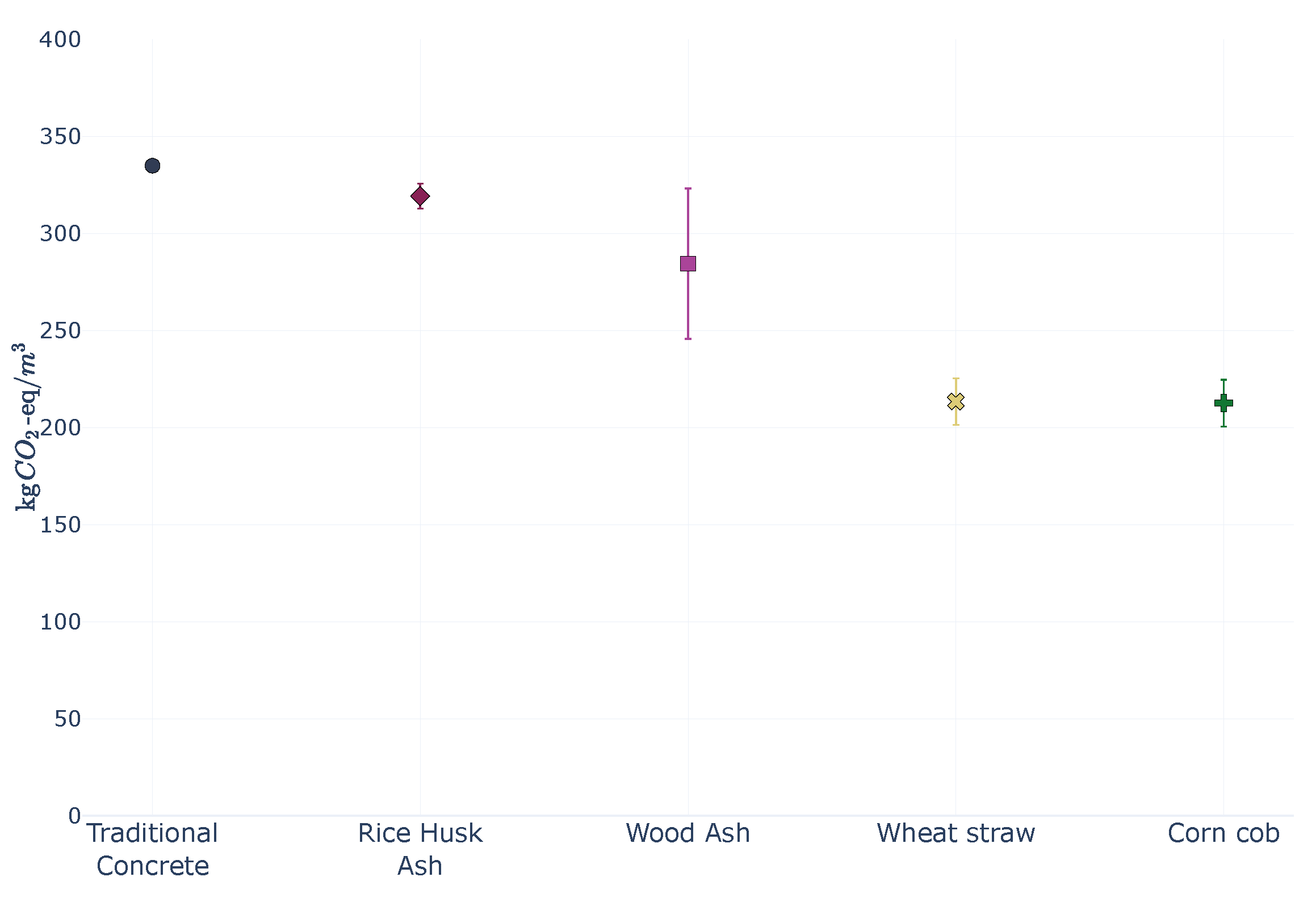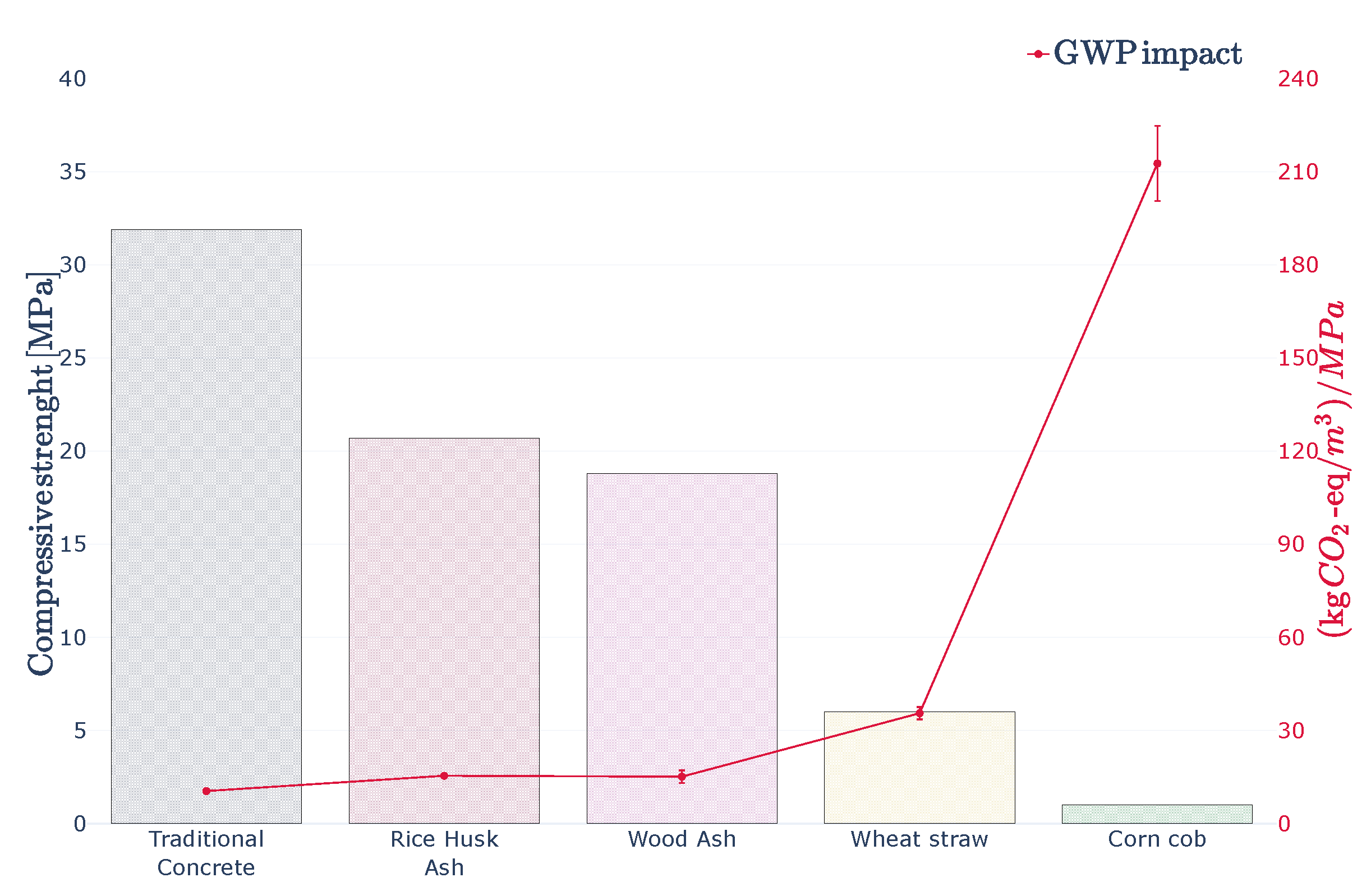Concrete with Organic Waste Materials as Aggregate Replacement
Abstract
:1. Introduction
2. Materials and Methods
2.1. Organic Waste Materials
2.2. Concrete Mix Design
2.3. Testing of Concrete Properties
2.4. LCA Methodology
2.4.1. Goal and Scope
2.4.2. Life Cycle Inventories
3. Results
3.1. Mechanical Tests’ Results
3.1.1. Slump Test
3.1.2. Compressive Strength Test
3.1.3. Flexural Strength Test
3.2. LCA Results per Declared Unit
LCA Results per Functional Unit
4. Conclusions and Future Developments
- A thorough investigation into the actual carbon storage at the end-of-life of concrete is essential. This requires exploring potential end-of-life scenarios to comprehensively assess the impact of these concrete mixes;
- While this study focused on the climate change impact category, the impact of using organic waste in concrete should be investigated more in detail for other environmental impact categories as well. The potential reduction in water consumption would be extremely important to investigate given the large water footprint of sand. In our study, we assumed that waste carries zero burden with it. However, if the waste is used in concrete, it could become a valorized co-product. Therefore, more research is needed on how to allocate the water consumed by the crop (and the other environmental impacts) to the products;
- Integrating a consequential life cycle assessment (LCA) is endorsed to evaluate the broader implications, encompassing economic, social, and environmental aspects, including the potential trade-offs in using organic waste for different purposes [44]. Moreover, it could be important to carry out a social LCA to understand the implications of illegal mining of sand;
- Further laboratory investigations are recommended to optimize the mechanical properties of concrete using organic waste. In particular, it is recommended to understand the evolution of the mechanical properties and durability of concrete with different organic waste replacement rates and consider longer curing times. Indeed, in this study, 14-day mechanical strength tests were performed, whereas a 28-day mechanical strength is more generally accepted. Furthermore, an extended observation period is recommended to assess the potential deterioration of organic waste particles within the concrete matrix.
Supplementary Materials
Author Contributions
Funding
Institutional Review Board Statement
Informed Consent Statement
Data Availability Statement
Conflicts of Interest
Disclaimer
Abbreviations
| DU | Declared unit |
| FU | Functional unit |
| GB | Great Britain |
| GHG | Greenhouse gases |
| GWP | Global Warming Potential |
| LCA | Life cycle assessment |
References
- Dooley, E.E. Concrete’s carbon footprint. Environ. Health Perspect. 2009, 117, A295. [Google Scholar]
- Akan, M.Ö.A.; Dhavale, D.G.; Sarkis, J. Greenhouse gas emissions in the construction industry: An analysis and evaluation of a concrete supply chain. J. Clean. Prod. 2017, 167, 1195–1207. [Google Scholar] [CrossRef]
- Pacheco-Torgal, F.; Jalali, S. Earth construction: Lessons from the past for future eco-efficient construction. Constr. Build. Mater. 2012, 29, 512–519. [Google Scholar] [CrossRef]
- Memon, S.A.; Javed, U.; Haris, M.; Khushnood, R.A.; Kim, J. Incorporation of wheat straw ash as partial sand replacement for production of eco-friendly concrete. Materials 2021, 14, 2078. [Google Scholar] [CrossRef] [PubMed]
- Miller, S.A.; Horvath, A.; Monteiro, P.J. Impacts of booming concrete production on water resources worldwide. Nat. Sustain. 2018, 1, 69–76. [Google Scholar] [CrossRef]
- Darvish, P.; Alengaram, U.J.; Poh, Y.S.; Ibrahim, S.; Yusoff, S. Volume based design approach for sustainable palm oil clinker as whole replacement for conventional sand in mortar. J. Build. Eng. 2020, 32, 101660. [Google Scholar] [CrossRef]
- UNEP. Sand and Sustainability: Finding New Solutions for Environmental Governance of Global Sand Resources; United Nations Environment Programme: Geneva, Switzerland, 2019; p. 35. [Google Scholar]
- Bendixen, M.; Best, J.; Hackney, C.; Iversen, L.L. Time is running out for sand. Nature 2019, 571, 29–31. [Google Scholar] [CrossRef]
- Mahadevan, P. Sand Mafias in India; The Global Initiative against Transnational Organized Crime: Geneva, Switzerland, 2019; Volume 237. [Google Scholar]
- Gursel, A.P.; Maryman, H.; Ostertag, C. A life-cycle approach to environmental, mechanical, and durability properties of “green” concrete mixes with rice husk ash. J. Clean. Prod. 2016, 112, 823–836. [Google Scholar] [CrossRef]
- Pittau, F.; Krause, F.; Lumia, G.; Habert, G. Fast-growing bio-based materials as an opportunity for storing carbon in exterior walls. Build. Environ. 2018, 129, 117–129. [Google Scholar] [CrossRef]
- Javali, S.; Chandrashekar, A.; Naganna, S.R.; Manu, D.; Hiremath, P.; Preethi, H.; Vinod Kumar, N. Eco-concrete for sustainability: Utilizing aluminium dross and iron slag as partial replacement materials. Clean Technol. Environ. Policy 2017, 19, 2291–2304. [Google Scholar] [CrossRef]
- Beiser, V. Why the world is running out of sand. BBC Future 2019, 18, 8. [Google Scholar]
- Memon, S.A.; Javed, U.; Khushnood, R.A. Eco-friendly utilization of corncob ash as partial replacement of sand in concrete. Constr. Build. Mater. 2019, 195, 165–177. [Google Scholar] [CrossRef]
- Fernando, S.; Gunasekara, C.; Law, D.W.; Nasvi, M.C.; Setunge, S.; Dissanayake, R. Life cycle assessment and cost analysis of fly ash–rice husk ash blended alkali-activated concrete. J. Environ. Manag. 2021, 295, 113140. [Google Scholar] [CrossRef] [PubMed]
- Siddique, R. Utilization of wood ash in concrete manufacturing. Resour. Conserv. Recycl. 2012, 67, 27–33. [Google Scholar] [CrossRef]
- Gaudreault, C.; Lama, I.; Sain, D. Is the beneficial use of wood ash environmentally beneficial? A screening-level life cycle assessment and uncertainty analysis. J. Ind. Ecol. 2020, 24, 1300–1309. [Google Scholar] [CrossRef]
- Pode, R. Potential applications of rice husk ash waste from rice husk biomass power plant. Renew. Sustain. Energy Rev. 2016, 53, 1468–1485. [Google Scholar] [CrossRef]
- Siddique, R.; Khan, M.I. Supplementary Cementing Materials; Springer Science & Business Media: Berlin/Heidelberg, Germany, 2011. [Google Scholar]
- Nagrale, S.D.; Hajare, H.; Modak, P.R. Utilization of Rice Husk Ash. Int. J. Eng. Res. 2012, 2, 1–5. [Google Scholar]
- Nehdi, M.; Duquette, J.; El Damatty, A. Performance of rice husk ash produced using a new technology as a mineral admixture in concrete. Cem. Concr. Res. 2003, 33, 1203–1210. [Google Scholar] [CrossRef]
- Bakker, R.; Elbersen, W.; Poppens, R.; Lesschen, J.P. Rice Straw and Wheat Straw-Potential Feedstocks for the Biobased Economy; Technical report; NL Agency: Dallas, TX, USA, 2013. [Google Scholar]
- Santolini, E.; Bovo, M.; Barbaresi, A.; Torreggiani, D.; Tassinari, P. Turning agricultural wastes into biomaterials: Assessing the sustainability of scenarios of circular valorization of corncob in a life-cycle perspective. Appl. Sci. 2021, 11, 6281. [Google Scholar] [CrossRef]
- Yahya, M.A.; Al-Qodah, Z.; Ngah, C.Z. Agricultural bio-waste materials as potential sustainable precursors used for activated carbon production: A review. Renew. Sustain. Energy Rev. 2015, 46, 218–235. [Google Scholar] [CrossRef]
- Tsai, W.; Chang, C.; Wang, S.; Chang, C.; Chien, S.; Sun, H. Cleaner production of carbon adsorbents by utilizing agricultural waste corncob. Resour. Conserv. Recycl. 2001, 32, 43–53. [Google Scholar] [CrossRef]
- BS 1881-125:2013; Testing Concrete Methods for Mixing and Sampling Fresh Concrete in the Laboratory. British Standards Institution: London, UK, 2013.
- BS EN 12350-2:2019; Testing Fresh Concrete. Slump Test. British Standards Institution: London, UK, 2019.
- BS EN 12390-3:2019; Testing Hardened Concrete. Compressive Strength of Test Specimens. British Standards Institution: London, UK, 2019.
- BS EN 12390-5:2019; Testing Hardened Concrete. Flexural Strength of Test Specimens. British Standards Institution: London, UK, 2019.
- Alaneme George, U.; Mbadike Elvis, M. Modelling of the mechanical properties of concrete with cement ratio partially replaced by aluminium waste and sawdust ash using artificial neural network. SN Appl. Sci. 2019, 1, 1514. [Google Scholar] [CrossRef]
- Ecoinvent, Allocation, Cut-Off by Classification, Ecoinvent Database Version 3.9.1. 2022. Available online: https://ecoinvent.org/the-ecoinvent-database/data-releases/ecoinvent-3-9-1/ (accessed on 14 July 2023).
- Brightway 2.5. Available online: https://github.com/brightway-lca/brightway25. (accessed on 14 July 2023).
- Mutel, C. Brightway: An open source framework for Life Cycle Assessment. J. Open Source Softw. 2017, 2, 236. [Google Scholar] [CrossRef]
- BS EN 15804:2012+A2:2019; Sustainability of ConstructionWorks—Environmental Product Declarations—Core Rules for the Product Category of Construction Products. British Standards Institution: London, UK, 2019.
- Hoxha, E.; Passer, A.; Saade, M.R.M.; Trigaux, D.; Shuttleworth, A.; Pittau, F.; Allacker, K.; Habert, G. Biogenic carbon in buildings: A critical overview of LCA methods. Build. Cities 2020, 1, 504–524. [Google Scholar] [CrossRef]
- Damineli, B.L.; Kemeid, F.M.; Aguiar, P.S.; John, V.M. Measuring the eco-efficiency of cement use. Cem. Concr. Compos. 2010, 32, 555–562. [Google Scholar] [CrossRef]
- Zhang, R.; Arrigoni, A.; Panesar, D.K. Could reactive MgO cement be a green solution? The effect of CO2 mineralization and manufacturing route on the potential global warming impact. Cem. Concr. Compos. 2021, 124, 104263. [Google Scholar] [CrossRef]
- Wu, P.; Xia, B.; Zhao, X. The importance of use and end-of-life phases to the life cycle greenhouse gas (GHG) emissions of concrete—A review. Renew. Sustain. Energy Rev. 2014, 37, 360–369. [Google Scholar] [CrossRef]
- Gebremariam, A.T.; Di Maio, F.; Vahidi, A.; Rem, P. Innovative technologies for recycling End-of-Life concrete waste in the built environment. Resour. Conserv. Recycl. 2020, 163, 104911. [Google Scholar] [CrossRef]
- Estate, T.C. Marine Aggregates, 2023. Available online: https://www.thecrownestate.co.uk/media/4505/marine-aggregates-annual-review-2023.pdf (accessed on 23 August 2023).
- Kemp, R. Energy Consumption of Marine Aggregate Extraction; Technical Report; Marine Estate Research Report Energy; The Crown Estate: London, UK, 2008; 21p, ISBN 978-0-9553427-9-0. [Google Scholar]
- Rigamonti, L.; Pantini, S.; Borghi, G. Relazione Finale Valutazione con Metodologia LCA (Life Cycle Assessment) dei Flussi e del Destino dei Rifiuti da Costruzione e Demolizione; Centro Studi MatER: Piacenza, Italy, 2017; p. 293. [Google Scholar]
- BS 5328-1:1997; Guide to Specifying Concrete. British Standards Institution: London, UK, 2002. Available online: https://www.bsigroup.com/en-GB/ (accessed on 2 November 2023).
- Earles, J.M.; Halog, A. Consequential life cycle assessment: A review. Int. J. Life Cycle Assess. 2011, 16, 445–453. [Google Scholar] [CrossRef]







| Scenario | Portland Cement (kg) | Water (kg) | Coarse Aggregate (kg) | Fine Aggregate (kg) | Organic Waste (kg) |
|---|---|---|---|---|---|
| Traditional concrete | 316 | 142 | 1276 | 704 | - |
| Concrete with organic waste | 316 | 142 | 1276 | 634 | 70 |
| Rice Husk Ash | Wood Ash | Wheat Straw | Corncob | |
|---|---|---|---|---|
| Biogenic carbon content (variation) | 5.5% (3%–8%) [21] | 19% (4%–34%) [16] | 46.5% (41.9%–51.1%) [24] | 46.8% (42.1%–51.5%) [25] |
| Concrete Samples | Slump Test Results (mm) |
|---|---|
| Traditional concrete | 110 |
| Rice husk ash | 90 |
| Wood ash | >200 (collapsed slump) |
| Wheat straw | 105 |
| Corncob | 75 |
Disclaimer/Publisher’s Note: The statements, opinions and data contained in all publications are solely those of the individual author(s) and contributor(s) and not of MDPI and/or the editor(s). MDPI and/or the editor(s) disclaim responsibility for any injury to people or property resulting from any ideas, methods, instructions or products referred to in the content. |
© 2023 by the authors. Licensee MDPI, Basel, Switzerland. This article is an open access article distributed under the terms and conditions of the Creative Commons Attribution (CC BY) license (https://creativecommons.org/licenses/by/4.0/).
Share and Cite
Bertoldo, N.; Qureshi, T.; Simpkins, D.; Arrigoni, A.; Dotelli, G. Concrete with Organic Waste Materials as Aggregate Replacement. Appl. Sci. 2024, 14, 108. https://doi.org/10.3390/app14010108
Bertoldo N, Qureshi T, Simpkins D, Arrigoni A, Dotelli G. Concrete with Organic Waste Materials as Aggregate Replacement. Applied Sciences. 2024; 14(1):108. https://doi.org/10.3390/app14010108
Chicago/Turabian StyleBertoldo, Nicolas, Tanvir Qureshi, Dylan Simpkins, Alessandro Arrigoni, and Giovanni Dotelli. 2024. "Concrete with Organic Waste Materials as Aggregate Replacement" Applied Sciences 14, no. 1: 108. https://doi.org/10.3390/app14010108






